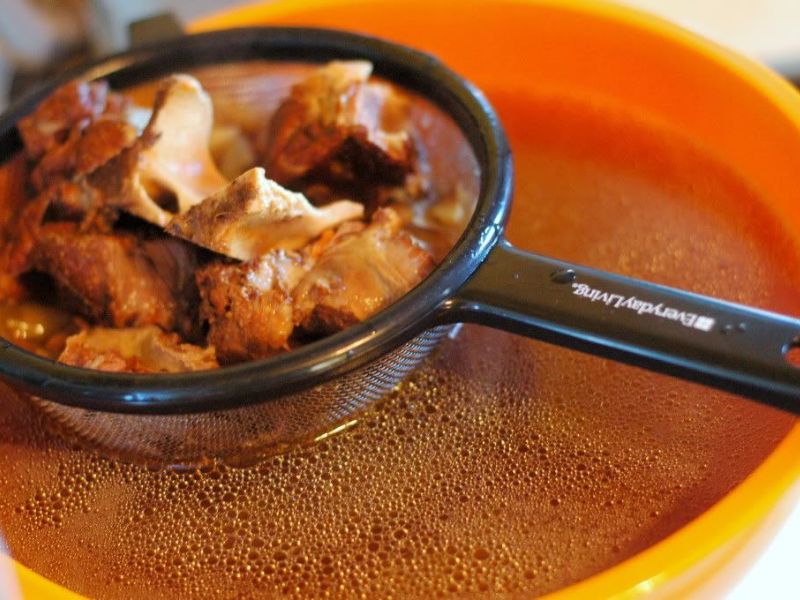Beef Consommé vs. Beef Broth: What’s the Difference?
If you’re on the lookout for delightful, flavorful liquids to enhance your dishes, beef consommé and beef broth are definitely worth considering. These two culinary delights share certain similarities on the surface, but their preparation methods and uses in the kitchen diverge significantly.
In this comprehensive article, we will delve into the distinctive characteristics of beef consommé vs beef broth. By exploring what sets them apart and understanding their unique qualities, you’ll be equipped to incorporate these delectable liquids into your culinary repertoire. Get ready to elevate your cooking game with beef consommé and beef broth as we embark on this flavorful journey together.
What is Beef Consommé?

Beef consommé, a traditional French dish originally denoting perfection or completeness, has a fascinating history rooted in medieval Europe when it was considered a luxury item accessible only to the wealthy.
Nowadays, consommé has evolved into a highly concentrated liquid used widely in the culinary world. Often served as an appetizer in upscale dining establishments, this versatile soup has found its way into various recipes as a replacement for water, adding depth and complexity to dishes such as soups, sauces, gravies, aspics, and even braised dishes.
Distinguished by its dark, velvety texture and rich flavor, beef consommé bears resemblance to beef broth, but with a heartier quality. The inclusion of gelatin gives it a unique consistency, falling somewhere between a thin jelly and a thick gravy. The process of transforming regular beef broth into consommé involves simmering and filtering, resulting in a final product that possesses a concentrated taste and an enticing aroma.
Preparing beef consommé involves several intricate steps. Beef broth or stock is simmered for an extended period, combined with egg whites and meat to create a complex flavor profile. As the mixture simmers, it gradually thickens. Subsequently, the liquid is meticulously strained to remove any residual impurities, yielding a concentrated amber-colored broth that serves as an exceptional flavor enhancer for a myriad of culinary creations.
While it is true that few individuals regularly prepare beef consommé at home, it can be readily purchased in the canned soup section of supermarkets. Nevertheless, I encourage you to embrace new culinary experiences whenever possible. Making beef consommé from scratch is a rewarding endeavor, and the cost involved is relatively modest when compared to its exquisite taste and culinary possibilities.
What Is Beef Broth?

Beef broth is a delightful liquid that emerges from the low simmering of beef, bones, or vegetables. Traditionally, soup would be crafted using solely the flesh and bones of beef. Nonetheless, the addition of vegetables greatly enhances the taste and richness of this delectable elixir. It is worth noting that the term “bouillon” is frequently used interchangeably with “broth.”
When it comes to creating broth, the three most commonly utilized vegetables are onions, celery, and carrots. However, parsley and peppers are also excellent choices for enhancing the flavors.
The process of making broth ensures that all the valuable nutrients present in vegetables and animal bones are fully utilized, resulting in a nourishing and wholesome liquid.
Although beef broth can be obtained from various sources, there is truly nothing that compares to a homemade version. While store-bought beef broth may be more convenient, the homemade variety boasts a remarkably richer flavor and aroma. Investing the time and effort to prepare beef broth at home is highly rewarding, as it offers exceptional nutrition and unparalleled taste.
It is quite common for beef broth to be mistaken for stock; however, there exists a distinct difference between the two. Broth is crafted by boiling ingredients, keeping some flesh intact, while stock is derived from simmering bones.
Overall, beef broth is a remarkable concoction that arises from carefully simmering a combination of beef, bones, and vegetables. Its versatility and unmatched flavor make it a worthwhile addition to various recipes and a delightful sip on its own.
Whether enjoyed in a homemade form or acquired from a store, beef broth serves as a testament to the culinary prowess of simmering and extracting the essence of quality ingredients.
Is Beef Consomme The Same As Beef Broth
No, beef consommé is not the same as beef broth. Beef consommé and beef broth may both contain beef as an ingredient, but they differ significantly in terms of preparation and flavor.
Beef broth is made by simmering cattle bones, flesh, and vegetables in water over a slow heat. Seasonings like salt are commonly added to enhance the taste. The resulting liquid becomes rich and flavorful due to the collagen and gelatin extracted from the bones. Beef broth serves as a foundational ingredient in various dishes such as soups, stews, sauces, and gravies, imparting its robust flavor and thick texture.
On the other hand, beef consommé is a concentrated and clarified version of beef broth. It begins with beef broth as a base, but goes through further refinement to remove impurities and achieve a clear, translucent appearance. This refining process, known as clarifying, involves adding ground beef, egg whites, and other ingredients to the broth.
As the mixture is gradually heated, the proteins from the egg whites coagulate and rise to the top, forming a “raft” that helps separate clean water from any remaining sediment. Once the consommé is gently strained through the raft, it becomes exceptionally clear and delicious.
Difference Between Beef Broth And Beef Consomme
Let’s explore and compare beef consomme and beef broth to understand their differences more comprehensively.
Base
Both beef consomme and beef broth start with a base of beef stock or broth. However, the preparation process sets them apart significantly. Beef consomme undergoes additional cooking and filtration stages, making it distinct from beef broth.
On the other hand, beef broth is a murky and dark liquid resulting from boiling beef with vegetables.
Flavor and Consistency
The two liquids exhibit notable variations in terms of taste and texture. Beef broth has a watery consistency when compared to beef consomme, which is more robust and concentrated.
Beef broth possesses a subtle beef taste, while beef consomme offers a rich and intensified beef flavor.
Outward Appearance
A quick visual inspection reveals the evident disparity between beef broth and beef consomme. Beef broth appears hazy and brownish due to the presence of contaminants.
In contrast, beef consomme lacks these impurities and boasts a clear, dark brown color.
Culinary Uses
Beef broth and beef consomme find diverse applications in the culinary world. With its elevated level of refinement, consomme can be enjoyed as an appetizer by itself, showcasing its sophistication and flavor profile.
On the other hand, beef broth is not typically consumed alone but rather used to enhance the taste of various dishes, such as soups and gravies. It serves as a versatile ingredient, adding depth to other recipes.
While beef consomme and beef broth have distinctive qualities, the latter can be substituted with the former in many instances due to their shared characteristics.
In summary, beef consomme and beef broth differ in their preparation methods, flavor profiles, appearances, and culinary applications. Beef consomme boasts a concentrated beef flavor, clear appearance, and versatility in various dishes, including being enjoyed as an appetizer. Beef broth, on the other hand, has a milder taste, murky appearance, and serves as an enhancer for soups and gravies. Despite their dissimilarities, there are enough similarities between them that allow for the substitution of one with the other in certain cases.





